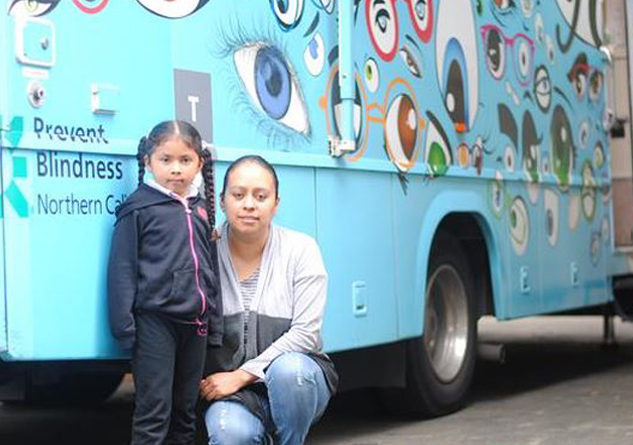Carlota del Portillo, April Nakayoshi, and Irene Kaufman
Prevent Blindness Northern California
Pre-school (ages 3-5) is an important time to check your child’s vision. A young child’s brain grows very fast, fed by what they see, hear and experience. Many preschoolers have undetected vision difficulties, making it harder to for them to learn, read or participate in activities in school.
Latino children have a higher prevalence of astigmatism, about 17% in Latino preschoolers, much higher than in African Americans (12.7%) and Caucasians (6.3%). (Ophthalmology. 2011 February; 118(2): 284–293). Children don’t know they have vision difficulties, never having seen clearly, and many parents do not know the importance vision screening at this young age. One difficulty is astigmatism (astigmatismo) that can make vision blurry and distorted. If not treated early, it becomes a permanent disability—when treated early, it often is easily corrected with glasses.
Prevent Blindness Northern California (PBNC), brings See Well to Learn (SWTL), a free/low cost vision screening program, to preschools in Alameda, San Francisco and San Mateo counties. We’ve screened over a million children in the last fifty years and we’ve caught vision issues that even well-child checkups have missed. In fact, in one study, over 30 percent of the children who failed our high-tech vision screening and ended up needing glasses had previously passed a routine screening at their pediatrician’s office. Our ambition is to have all preschoolers, regardless of background or income, have their eyes screened annually across the Bay Area. This year the goal is to serve 9,000 children, more than 44% of them Latinos, at 210 preschools.
Sanaa, a three-year old, didn’t seem interested in books or coloring at home, and sat very close to the television. Her mother thought this normal behavior for such a young child. After all, Sanaa had had her well-child check-ups where no vision problem had been diagnosed. See Well to Learn finds that over 60% children prescribed glasses on our mobile optometry clinic, the Eye Bus, had previously passed the vision portion of their well-child check-ups.
Last spring, the See Well to Learn vision team came to Sanaa’s preschool and performed vision screenings right there in the classroom. When her mother came that afternoon to pick her up from school, the teacher told her that Sanaa had a vision problem and would need a full eye exam and possibly glasses.
“I was really surprised that Sanaa might need glasses – and I wondered how much it might cost,” her mother said. “But I learned that See Well to Learn would be bringing their Eye Bus back to the school in a few weeks, and that they’d give Sanaa a full eye exam and it wouldn’t cost us a thing.” The optometrist on the Eye bus explained that Sanaa had moderate astigmatism in both eyes, making vision blurry and distorted and preventing her from seeing well.
Sanaa’s glasses were delivered to her school and fitted on her. And there was an immediate difference in her behavior. “She’s more focused – she’s more interested in books and pictures now, and her teachers tell me she’s more engaged in the classroom,” her mother says gratefully.
In addition to the Eye Bus that goes to preschools to check for vision difficulties early, SWTL staff also talk to parents and the teachers about vision and learning, and how to be sure children wear their glasses. In addition, parent education, in workshops or over the phone, is offered in English and Spanish.
Ask your preschool administrator or principal to call Prevent Blindness Northern California at (415) 567-7500 x103 for a possible visit from the See Well to Learn Eye Bus.
Prevent Blindness Northern California is a 501 c (3) nonprofit in San Francisco funded by grants and donations. To learn more, please visit www.seewelltolearn.org.






